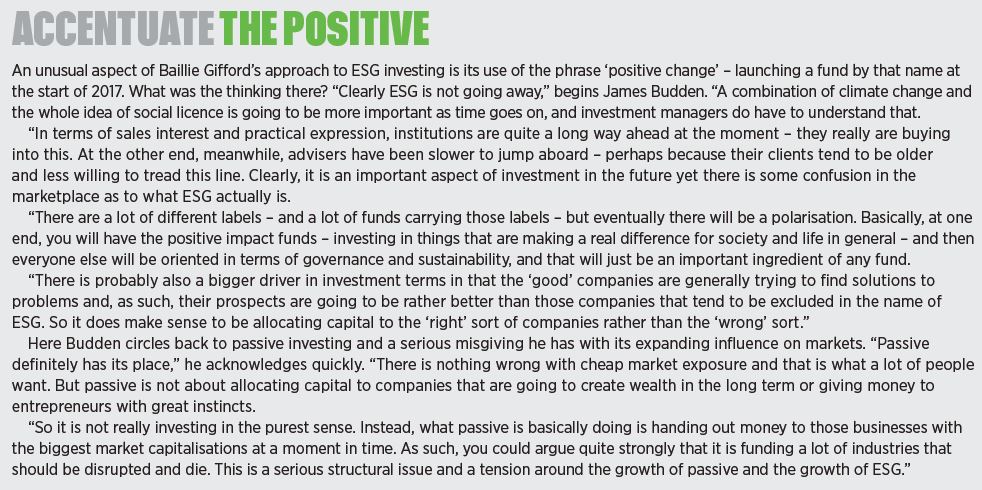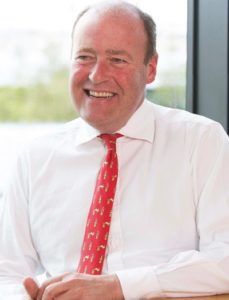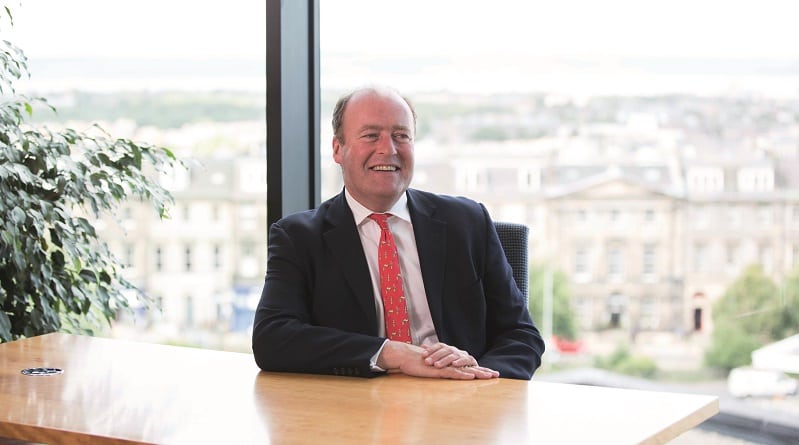“Why do we exist?” It is not a question you hear that often in conversations with senior members of the asset management sector – but, on reflection, it is one that probably ought to be addressed more. When James Budden ponders it, it is not philosophical self-analysis so much as weighing up asset management’s role in society – in effect, that the sector should have more to its essence than ‘I run money, therefore I am’.
The term he actually uses is ‘social licence’ – and while I nod knowingly at the time of our Zoom interview, a quick check of Investopedia afterwards confirms this refers to “the ongoing acceptance of a company or industry’s standard business practices and operating procedures by its employees, stakeholders and the general public”. It is, as you might imagine, closely related to the ideas of sustainable and responsible investing.
“Why do asset managers exist?” continues Budden, who joined Baillie Gifford as director of marketing and distribution at the sharp end of the global financial crisis, having held similar roles at Witan and Henderson.
“We need to be able, not necessarily to convince, but certainly to relay to the general public and investors that there is a purpose behind what we do – and that is not just to make money for those involved in the sector.
“It is actually about allocating capital to businesses that create wealth and find answers to big problems – be it Tesla, say, or an unlisted company such as Grail, which is trying to find a blood test for cancer. These sorts of things are really important and so, for asset managers, it comes down to the purposeful allocation of capital. That is what we need to try and get back to and the argument we need to make to the wider marketplace.
“Otherwise, if we are merely trading with each other, what is the point of that? It may be great for the market participants, who are all taking a cut, but it is not great for the end-investor and it is not great for wider society – and it is not creating any wealth. That has to be a long-term goal for the industry – although, if you work back from that, it does call for cultural change in a lot of cases.”
Baillie Gifford thanks its investment trust roots for its relationships with wealth managers
If asset management can get this right, Budden envisages a “pretty positive outlook” over the coming decade, stemming from secular changes around pension freedom, auto-enrolment and inheritances from baby-boomers. “Add in a greater need for savings advice and the repatriation of direct equity investments and big cash holdings into funds,” he adds, “and there are lots of opportunities for both asset managers and the distribution chain.”
Key players here will be “intermediaries and gatekeepers”, Budden reckons, adding: “By intermediaries, I mean not just the wealth management sector but also the adviser sector, while the gatekeepers, more broadly, are the ratings agencies and those who put together central investment propositions, model portfolios and the like. They are going to be pretty important in defining who is successful and who is not.”
Thanks to its investment trust roots, Baillie Gifford has traditionally enjoyed good relationships with wealth managers – something the company now hopes to replicate with financial advisers.
“The RDR is in the process of professionalising the advisory sector and there is a growing need for advice,” according to Budden. “At the end of the day, advisers will be talking to end-investors, so we see a real case for long-term investment here.
“We are building up a team to work directly with IFAs on an individual basis yet we also see a lot of our peer group have come away from this area. Go back in time and distribution was perhaps driven by a combination of big sales force relationships, big brand, dare I say commission and the things that brought that all together – whether that was the golf course, say, or the cruise ship.
“But things have changed and the likes of Morningstar, RSMR and Square Mile are increasingly important in filtering out funds – likewise discretionary fund managers, model portfolios and centralisation. I mentioned the opportunities for asset managers but they also face some very big challenges – and an obvious one is this dislocation in distribution.”
Asset management M&A is just ‘delaying the inevitable’
“Then there is the huge threat from passive – if you are going to charge 75bps, and you are up against someone charging 7bps, you have to be able to produce the goods. That is something some of the bigger asset managers are now trying to come to terms with because they are still stuck in a world where it is all about distribution rather than proposition – and that is a dangerous place to be.”
For Budden, this also links with the upturn in M&A activity among asset managers. “You see these companies thinking size is key and, if they come together and suddenly double the amount of assets they have, everything will be OK. But all you are really doing is delaying the inevitable. If you cannot demonstrate your proposition can outperform a passive index over a five to 10-year horizon then, really, what is the point of you?
“This is a real problem for some of the better-known investment houses out there and they are under pressure. As I say, either they come together or they basically cut their prices in the hope of buying distribution by halving their margins – and that is a fairly short-term view of survival. So there is a bit of a shake-up on the horizon unless groups can understand and come up with a process and proposition that works.”

This seems an appropriate time to ask how Budden would set about building a good-sized asset manager from scratch – but he is quick to seize on the flaw in the question. “The real key is to have an investment process and proposition that is robust, sustainable and successful, which is quite a difficult thing to do from scratch,” he says. “Once you have that, though, then promotion, distribution and so on will follow – if you can invest in it.”
The other crucial ingredient, Budden continues, is the right culture. “You have to align yourselves with your customers, your employees and the general public – to look outwards to them continually,” he elaborates. “And yet a lot of the investment industry is simply not aligned with the needs of its customers – just think about the different elements of a classic investment arrangement.”
The partnership structure takes some of the heat off
“People need to invest in a pension fund for 20 or 30 years or more – but then you have trustees who are on a board for five years, who appoint a manager who is judged on an annual basis, while investing in companies whose CEOs are rewarded on quarterly earnings. There is a massive misalignment here and a successful investment business has to stand away from that and take a long-term view.
“That calls for patience and also, in the sense that it is behaviourally very difficult to do, bravery. And yet, if your culture underpins that way of looking at things, you have a tremendous competitive advantage over those in your peer group who are, on the whole, taking very short-term decisions, being very index-aware and, more often than not, trading with themselves.”
Unsurprisingly, perhaps, Budden suggests Baillie Gifford’s partnership structure is an advantage here.
“There are a lot of extraneous pressures – certainly on listed asset management companies as, structurally, they are not able to take a particularly long-term view of things,” he says. “Obviously, being a partnership allows us to do that because, in investment, we don’t have to do what we don’t want to do. In times of stress, that is pretty valuable.”

Does Budden see culture and brand as the same thing? “A brand is really a blend of culture and proposition,” he replies. “You can dress it up however you want to creatively and align it with whatever values you think fit, but that is the core of it. Essentially, it is culture and a proposition that is clearly defined and differentiated, as well as honest, transparent, understandable, sustainable and so on.”
What about trust? “I always think expecting trust – certainly in financial services – is a step too far,” he says. “Trust is something you have with family and friends, not with banks and asset managers, so we do not expect trust. What you want is people to think you are reliable and doing what you said you would and so they stay with you. At heart, your brand has to instil confidence in you as a provider.”
Only a few active asset managers have been able to sustain positive flows
Being seen to offer value for money should also help. “This is a key factor,” acknowledges Budden. “You have this real problem with swathes of the active industry where they do not beat the index yet still charge big prices. Clearly there needs to be a relationship between the returns you expect to provide and the price you charge. That relationship has to be transparent but it should also aim to be progressive.
“What we try and do here is, if we have a strategy that is very well-funded and has no particular capacity issues, we will have a long, hard look and see how we can pass on the economies of scale to the end-customer.
“We have done that relatively recently, for instance, with our American fund, which we cut from 65bps to 50bps, and we have done it with our investment trust range, which is tiered.
“So the progressive nature of value-for-money is an important ingredient in the concept. At the end of the day, though, investors want good returns over the long term – over a five to 10-year period – and if you can also charge them a reasonable price for that, then you are off to the races. It is when that relationship breaks down it becomes an issue.”
Asked to peer into his crystal ball, Budden suggests the asset management sector could appear very different in a decade’s time. “If you look at fund flows in the UK over the past couple of years – with the exception of us and, more latterly, Liontrust – the companies that have been resolutely at the top of the list are underpinned by passive flows,” he observes.
“If you extrapolate that, then, unless a lot of groups sharpen up their propositions, the future will be dominated by big passive providers and – hopefully – some fantastically good active managers.
“I would like to think we will be part of that and the likes of Artemis, Polar, T Rowe Price – companies that will have an across-the range ability to provide excellent, value-for-money active management that can outperform in the long term.
“And then you will have a series of niche boutiques that are essentially very good at certain areas. These will be ‘refugees’ from the bigger fund management companies – indeed, it is already beginning to happen. That is likely to be the progression but what one used to term ‘mainstream retail asset managers’ in the UK – there is now a lot of stress and strain around them.”
QUICKFIRE Q&A
What is the best piece of advice you have ever been given?
If at first you don’t succeed – try, try again.
What is your ‘top tip’ for professional managers to help them run a better business?
Look for quality, not just price.
What single issue should most concern professional investors at present?
Well, obviously …

Does anything about your job keep you awake at night?
The constant changing of technology and systems is a bit tricky for a pre-digital person like me.
And what most excites you about your job?
The opportunity. Certainly, as a business, the world is our oyster. And, more generally, the changing nature of the sector we are in – nothing really stands still in asset management.
If you were head of the FCA for a day, what’s the first thing you would do?
I would lobby the government to introduce personal finance into the curriculum.
And what advice would you give to someone starting out in investment today?
Treat investment as an intellectual or academic pursuit rather than solely as a way of making money. Don’t just live by economic theory – try to be curious and patient in your approach and decision-making.







